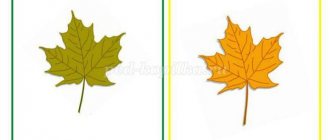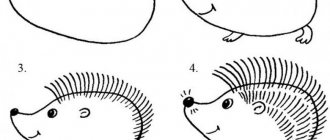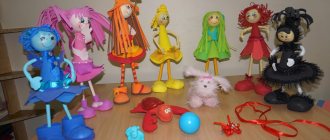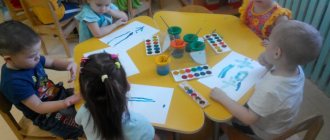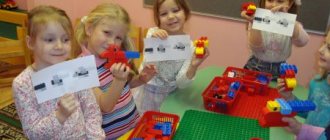Summary of a drawing lesson in the middle group “Draw a picture about summer rain”
Alina Budylskaya
Summary of a drawing lesson in the middle group “Draw a picture about summer rain”
“Draw a picture about summer rain”
Goal: - to teach children to reflect their impressions ways
- consolidate the techniques of drawing with wax crayons , painting with a brush , the ability to hold a brush correctly, and rinse it in water;
- encourage drawing of different objects in accordance with the content of the drawing;
- to arouse in children an interest in nature, the ability to see its beauty.
Materials: album sheets, wax crayons, paints, brushes, cups of water, napkin.
Summary of GCD for drawing on the topic: “Rain”
Ekaterina Verkhovskaya
Summary of GCD for drawing on the topic: “Rain”
Goal: development of artistic and aesthetic feelings through gaming activities.
— Teach children to depict rain with finger paints;
— Develop the ability to rhythmically apply strokes to the entire surface of the sheet;
— Develop the ability to listen and hear the teacher.
Equipment: blue finger paints, a white sheet of paper, blue clouds prepared by the teacher.
Progress of the lesson:
1. Organizational moment. Conversation.
The sun is shining, the waters are sparkling,
Smile in everything, life in everything,
The trees tremble joyfully
Bathing in the blue sky.
Children, what time of year is this poem about? (about summer)
.Today we will talk about the beauty of nature in summer.
Look at the picture . How was the sun shining in summer? (Brightly.)
What, look, what did the flower bed look like in the summer?
(green, blooming, fragrant, fragrant, colorful, fragrant, sunny, etc.) What was the weather like yesterday, today (
rainy , sunny, cloudy) .
What natural phenomena can be observed in the summer when it rains ? (thunder, lightning, rainbow)
. Guess riddles about natural phenomena.
•What a wonderful beauty!
Showed up on the way!
•Grown into the ground for a minute
The bridge is high without railings.
2. Preparation for practical activities.
– Today we will draw a picture about summer rain .
Show with explanation.
The teacher and the children draw the sun, rainbow, rain , cloudy sky -
Before we get started, let's do some finger exercises.
Rain , rain , more fun
Drip, drip, don't be sorry!
Just don't kill us!
Don't knock on the window in vain -
Splash more into the field:
3. Practical independent activity
5. Result of the activity: We got a wonderful summer rain , let's place our works on the table and choose the most beautiful one.
Summary of GCD for drawing in the middle group “Complete the picture” Summary of GCD for drawing in the middle group “Complete the picture” Elena Lezgovko In the middle group Goal: Teach children to draw images based on.
Notes for a lesson on speech development in the middle group “The Tale of the Easter Bunny” Notes for the development of speech in the middle group Reading the work “The Tale of the Easter Bunny” Purpose: to teach children to listen carefully to the work.
Summary of a lesson on appliqué with drawing elements with children of the second junior group “Rain, Rain” Purpose: To create conditions for the development of children’s creative abilities. Objectives: consolidate the ability to paste ready-made forms onto the background, consolidate.
Summary of the lesson on drawing “Snowman” in the middle group “Snowman” Program content: 1. Educational objectives: Continue to develop children’s ability to draw an object consisting of several.
Lesson summary for the middle group “Draw a picture about spring.” Lesson summary for the middle group “Draw a picture about spring.” Tasks. Teach children to convey impressions of spring in drawings. Develop.
Lesson notes for the second junior group “Autumn Rain” (subject drawing) Objectives: familiarization with the signs of autumn rainy weather; creating a composition. Objectives: continue to familiarize children with the signs.
Lesson summary about a winter walk in the middle group “Snowfall” Purpose: To introduce children to the seasonal phenomenon of snowfall. Increase children's physical activity and develop physical skills. Summary of GCD for drawing “Draw something round” GCD for the educational field “Artistic and aesthetic creativity (drawing) “Draw something round.” Program content: Exercise.
Technological map of the direct educational drawing activity “Draw a picture about summer” Program content. Teach children to reflect their impressions in accessible ways. Reinforce brush painting techniques and skills correctly.
Drawing lesson in the middle group “Draw a picture about spring” Drawing lesson in the middle group Teacher: Kovalevskaya L.N. Theme. Draw a picture about spring. Objectives: teach children to convey in drawing.
Source
Summary of educational activities in drawing for the middle group “Rain, rain, drop”
Svetlana Azyrkina
Summary of educational activities in drawing for the middle group “Rain, rain, drop”
Teach children to create an image of rain drawing method (using pipettes)
.
Educational: evoke an emotional response, cultivate a sensitive and caring attitude towards nature and the beauty of the surrounding world.
Educational: learn to draw rain with a pipette , evenly distributing drops of water over the surface of a landscape sheet. Continue to teach how to convey simple phenomena of reality in drawing. Learn to combine actions with the words of a poem.
Developmental: develop imagination , fine motor skills, aesthetic attitude to the surrounding world.
White album sheet, plastic glasses with water. Palette with paints, brushes, wet wipes. Brush holders, easel, umbrella.
Verbal, practical, visual.
Drawing with plasticine and fingers. Reading nursery rhymes and poems about rain .
On the topic: methodological developments, presentations and notes
Goal: To teach children to create an image of rain using an unconventional drawing method (using pipettes).
Program content: Teach children to create an image of rain using an unconventional drawing method (using pipettes). Objectives: Educational: evoke an emotional response, cultivate a sensitive and caring attitude.
The purpose of the lesson was to introduce children to a new type of unconventional drawing technique “blotography”. To consolidate the idea of different states of water. Educational: Introduce children to the method.
Outline of a drawing lesson in the junior group of kindergarten. This material will be useful to teachers of the younger group during directly organized drawing activities.
Program content:Creating an image of rain using pipettes. Objectives: Educational: evoke an emotional response, cultivate a sensitive and caring attitude towards nature and the beauty of the world around us.
Summary of organized educational activities on drawing in the junior group of a kindergarten for children with severe speech impairments “Ladybug”.
Summary of educational activities in drawing for the middle group of kindergarten on the topic: “Rain, rain, drop.”
Source
Progress of the lesson:
I. Organizational moment
Hello guys! (An audio recording of the sound of rain )
.
Children, listen, what do you think this sound is like? (To the sound
of rain ) .
this rain ? (Water drops)
.
Setting the goal of the lesson:
Guys, let's draw raindrops with water . Please come to my table. (Children approach the demonstration table)
.
II. Creative and exploratory work of children
Guys, please guess the riddle:
Sacks with holes are running,
Water is leaking from the bags.
That's right, it's a cloud. Look how I draw a cloud with wax crayons. (The teacher demonstrates the technique of drawing clouds with wax crayons. While drawing , the teacher talks with the children about clouds and clouds).
What falls from the cloud to the ground? ( Rain , hail, snow)
.
Where can it rain ? (On the street)
.
rain from my cloud now . I'll paint it with water.
Look what's in the glass? (Water)
.
What color is the water? (Transparent)
.
Do you think it is possible to draw raindrops with clear water ? (No)
.
Why? (The droplet will not be visible)
.
So, what do we need to do with the water to make it visible? (Paint the water with paint)
Well done, you guessed it.
(The teacher invites one of the children to paint over the water in a glass with a brush with gouache).
Educator: What color is the water in the glass? (Children name the color of the water in the glass. The color can be different, at the child’s discretion, since the palette contains gouache of different colors).
Educator: Look what I have in my hands? (Shows a pipette)
.
That's right, a pipette. We will draw raindrops with an eyedropper .
Clarification of safety rules: Look, the pipette is made of glass. Can you put glass in your mouth? (No)
.
Throw the pipette on the floor? (No)
.
Why? (May break and cut yourself with glass shards)
.
Watch how I draw rain with an eyedropper . (The teacher demonstrates the technique of drawing rain with water from a pipette . As the show progresses, she tells and shows how to draw water into a pipette and distribute droplets of water over the entire surface of the album sheet).
Educator: Now, guys, let’s prepare our fingers for drawing .
Finger gymnastics " Rain "
Rain , rain , drop,
I cut a puddle, I cut a puddle,
Cut, cut, didn't cut,
And he got tired and stopped. (I. Tokmakova)
(Children rhythmically tap the palm of their other hand with their index finger, gradually slowing down the pace, according to the text of the poem).
Educator: Guys, close your eyes, listen to the sound of the rain and think what color your rain . (An audio recording of the sound of rain )
.
Have you thought about it? Now sit down at your desks and get to work. ( Children’s . Individual help from the teacher as needed. While the children an audio recording of the sound of rain ). Smart girls. Now the rain . In the meantime, while the raindrops are drying from your clouds, come out to me and let’s play a game.
Dynamic game " Rain "
Rain , rain , rain and rain. (Children show raindrops on their palms with their fingers )
Don't be sorry for the wet drops.
We clap our hands
(Perform movements according to the text of the poem)
The sun came out again and
the children all go for a walk.
(Perform movements according to the text of the poem)
(An audio recording of the sounds of rain , children run away under the teacher’s umbrella).
The game is over and your raindrops have dried up . Please take your works and bring them to my table.
What a fabulous, unusual rain you made ! (The teacher and the children look at the drawings and discuss the color of the rain ).
Guys, what did you draw ?
How did you draw raindrops ?
Did you like the lesson?
As a keepsake of our lesson, I give you balloons. They are blue and look like raindrops .
Summary of direct educational activities for children of the middle group “Autumn is a marvelous artist” MKU “Education Department of the Administration of the city of Apatity, Murmansk region” municipal budgetary educational institution for children.
Summary of direct educational activities for children of the preparatory group for school. TOPIC “WHAT HELPES YOU BE STRONG AND AGIL” (according to the program “Talk about health and proper nutrition”) SLOGAN “If you play sports.
Summary of direct educational activities for children of the senior group “Vesna-Krasna” Synopsis of direct educational activities for children of the senior group according to FEEP Topic: “Spring-Red” Educational activities.
Summary of direct educational activities on the application for the middle group “Multi-colored umbrellas” Integration of educational areas: Artistic and aesthetic development, cognitive development, speech development. Goal: teach children to compose. Summary of direct educational activities on drawing in the middle group “Winter Forest” Goal: Development of children’s creative abilities, creating drawings in non-traditional techniques. Educational objectives: Teach children: compose.
Preview:
Summary of GCD for drawing middle group
(Unconventional technique: painting with cotton swabs)
— Teach children to draw dots and spots using cotton swabs, depicting clouds and rain.
— Introduce children to accessible natural phenomena; continue to learn to distinguish the color of paint, to name it correctly (blue).
— Form the correct posture when drawing: sit freely, do not lean low over the sheet of paper, hold the sheet of paper with your free hand.
— Develop the desire to play outdoor games with simple content.
Means of implementation: sheets of white paper with images of clouds, cotton swabs, blue gouache paints, napkins, variable samples to explain drawing techniques, an umbrella, frogs - toys.
Educator: Guys, do you hear someone scratching at our door. Let's get a look. (Brings in frogs on a tray).
Educator: Children, who came to visit us?
The teacher recites the poem:
We are green frogs
We are cheerful croaks,
Educator: Do you know how frogs sing songs? But now the frogs are sad for some reason. Guys, what do you think happened, why aren’t they having fun? Frogs love rain very much; there are a lot of puddles and they can swim and splash in them. But it hasn’t rained for a long time, so the frogs are sad. We can help the frogs and draw clouds and rain. We will draw with cotton swabs.
(The teacher shows a sample of the work, explains the frequency of placing dots and spots).
Educator: We draw spots on the cloud close to each other, they almost merge, and the spots - rain are placed freely, “flying” at a distance from each other. Guys, what color are the clouds and rain? (children's answers)
(Children sit down at the table and begin to draw with cotton swabs. First, they fill in the silhouettes of clouds with spots.)
Finger game Rain, pour some rain, There will be a loaf of bread. There will be rolls, there will be baked goods, there will be delicious cheesecakes.
(Then the children draw rain, put rarer spots under the clouds - show how rain comes from the clouds.
The teacher encourages the children to follow the rhythm of the prints.
Rain, rain drip - drip - drip
We can't go for a walk
We'll get our feet wet.
Educator: But frogs love the rain and are not afraid to get their paws wet.
(The guys look at the resulting drawings together with the frogs.)
Educator: Well, frogs, are you happy, we drew you a lot of rain. Now you can splash and have fun in the puddles. And the guys and I will still play.
Outdoor game: “Sunshine and Rain.”
Sunshine and rain
develop in children the ability to run in all directions, without bumping into each other, and to quickly respond to a signal.
The game can be played both indoors and outdoors. The houses are either chairs or circles on the ground.
The teacher turns the children's highchair backwards and invites everyone to do the same with their own highchairs. “Look, it turned out to be a house,” he says, sitting down in front of the chair and looking through the hole in the back, like through a window. Calling the children by name, the adult invites each of them to “look out the window” and wave his hand.
So the chairs arranged in a semicircle become houses in which children live.
"What a nice weather! - says the teacher, looking out the window. “Now I’ll go out and call the kids to play!” He goes out into the middle of the room and invites everyone to take a walk. The kids run out and gather around the teacher, and he says the following text:
The sun looks out the window,
Our eyes narrow.
We will clap our hands
And run outside!
The children repeat the rhyme, and then, to the words “Top-top-top” and “Clap-clap-clap,” they all stomp their feet and clap their hands, imitating the teacher.
“Now let’s run!” — the teacher suggests and runs away. The children run away in different directions. Suddenly the teacher says: “Look, it’s raining! Hurry up and go home!” Everyone rushes to their houses.
“Listen to how the rain drums on the roofs,” says the teacher and, tapping the seat of the chair with his bent fingers, imitates the sound of rain. - It became very boring. Let's ask the rain to stop falling." The teacher reads a folk nursery rhyme:
Rain, rain, more fun,
Drip, don’t spare a drop.
Just don't kill us,
Don't knock on the window in vain!
The sound of rain intensifies at first, but gradually subsides, and soon stops completely. “Now I’ll go outside and see if the rain has stopped or not,” says the teacher, leaving his house. He pretends to look at the sky and calls to the kids: “The sun is shining! No rain! Go out for a walk!”
The children again gather around the teacher and, after him, repeat the poem about the sun and perform funny movements. You can run, jump, dance, but until the teacher says again: “Oh, it’s starting to rain!”
Source

